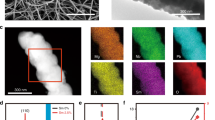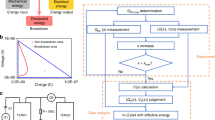Abstract
Piezoelectric nanogenerators (NGs) have been developed for converting mechanical energy into electric energy using ZnO, GaN, ZnSnO3, and PZT nanowires. Due to the unique polarity and non-central symmetry of the wurtzite structure, a composite made of using the conical shaped nanowires are used as a simple, cost-effective, and scalable nanogenerator. Based on the finite element methods, the output voltage of the nanogenerator is modeled numerically. The key factors: the spatial location of nanowires, length and dip angle of nanowires, thickness of NG devices, and the physical properties of the polymer inside NGs, which affect the output voltage are studied. The results provide guidance for optimization the output of piezoelectric nanogenerators.
Similar content being viewed by others
References
Wang Z L, Song J. Piezoelectric nanogen-erators based on zinc oxide nanowire arrays. Science, 2006, 312: 242–246
Wang Z L. Energy harvesting for self-powered nanosystems. Nano Res, 2008, 1(1): 1–8
Wang Z L. Towards self-powered nanosystems: From nanogenerators to nanopiezotronics. Adv Funct Mater, 2008, 18(22): 3553–3567
Wang Z L. Energy harvesting using piezoelectric nanowires-A correspondence on “energy harvesting using nanowires?” by Alexe et al. Adv Mater, 2009, 21(13): 1311–1315
Wang Z L, Wu W. Nanotechnology-enabled energy harvesting for self-powered micro-/nanosystems. Angew Chem Int Ed Engl, 2012, 51(47): 11700–21
Wang Z L. Nanomaterials: Sticky but not messy. Nat Nanotechnol, 2009, 4(7): 407–8
Wang Z L. Progress in piezotronics and piezo-phototronics. Adv Mater, 2012, 24(34): 4632–4646
Wang S, Lin L, Wang Z L. Nanoscale triboelectric-effect-enabled energy conversion for sustainably powering portable electronics. Nano Lett, 2012, 12(12): 6339–6346
Yang X H, Zhu G, Wang S H, et al. A self-powered electrochromic device driven by a nanogenerator. Energ Environ Sci, 2012, 5(11): 9462
Lee S, Bae S H, Lin L, et al. Super-flexible nanogenerator for energy harvesting from gentle wind and as an active deformation sensor. Adv Funct Mater, 2013, 23(19): 2445–2449
Su Y J, Yang Y, Zhang H L, et al. Enhanced photodegradation of methyl orange with TiO2 nanoparticles using a triboelectric nanogenerator. Nanotechnology, 2013, 24(29): 295401
Zhu G, Pan C, Zhu W, et al. Triboelectric-generator-driven pulse electrodeposition for micropatterning. Nano Lett, 2012, 12(9): 4960–5
Xu S, Wang Z L. One-dimensional ZnO nanostructures: Solution growth and functional properties. Nano Res, 2011, 4(11): 1013–1098
Wang Z L. Toward self-powered sensor networks. Nano Today, 2010, 5(6): 512–514
Wang Z L. Self-powered nanosensors and nanosystems. Adv Mater, 2012, 24(2): 280–5
Hu Y F, Zhang Y, Xu C, et al. High-output nanogenerator by rational unipolar assembly of conical nanowires and its application for driving a small liquid crystal display. Nano Lett, 2010, 10: 5025–5031
Lin L, et al. Transparent flexible nanogenerator as self-powered sensor for transportation monitoring. Nano Energy, 2013, 2(1): 75–81
Wang Z L. From nanogenerators to piezotronics-A decade-long study of ZnO nanostructures. MRS Bull, 2012, 37(09): 814–827
Patel R, McWilliam S, Popov A A. A geometric parameter study of piezoelectric coverage on a rectangular cantilever energy harvester. Smart Mater Struct, 2011, 20(8): 085004
Shu Y C, Lien I C. Analysis of power output for piezoelectric energy harvesting systems. Smart Mater Struct, 2006, 15(6): 1499–1512
Shu Y C, Lien I C, Wu W J. An improved analysis of the SSHI interface in piezoelectric energy harvesting. Smart Mater Struct, 2007, 16(6): 2253–2264
Sun C, Shi J, Wang X. Fundamental study of mechanical energy harvesting using piezoelectric nanostructures. J Appl Phys, 2010, 108(3): 034309
Zhao S, Erturk A. Electroelastic modeling and experimental validations of piezoelectric energy harvesting from broadband random vibrations of cantilevered bimorphs. Smart Mater Struct, 2013, 22(1): 015002
Ajitsaria J, Choe S Y, Shen D, et al. Modeling and analysis of a bimorph piezoelectric cantilever beam for voltage generation. Smart Mater Struct, 2007, 16(2): 447–454
Comsol Model Gallery (Electrostatic Potential Between Two Cylinders), http://www.comsol.com/showroom/gallery/118/, accessed June 2013
Zhang Y, Liu Y, Wang Z L. Fundamental theory of piezotronics. Adv Mater, 2011, 23(27): 3004–13
Romano G, Mantini G, Di Carlo A, et al. Piezoelectric potential in vertically aligned nanowires for high output nanogenerators. Nanotechnology, 2011, 22(46): 465401
Lu M Y, Chen L J, Mai W, et al. Tunable electric and magnetic properties of CoxZn1-x S nanowires. Appl Phys Lett, 2008, 93(24): 242503
Park K I, Xu S, Liu Y, et al. Piezoelectric BaTiO(3) thin film nanogenerator on plastic substrates. Nano Lett, 2010, 10(12): 4939–4943
Author information
Authors and Affiliations
Corresponding author
Rights and permissions
About this article
Cite this article
Huang, X., Li, L. & Zhang, Y. Modeling the open circuit output voltage of piezoelectric nanogenerator. Sci. China Technol. Sci. 56, 2622–2629 (2013). https://doi.org/10.1007/s11431-013-5352-9
Received:
Accepted:
Published:
Issue Date:
DOI: https://doi.org/10.1007/s11431-013-5352-9




